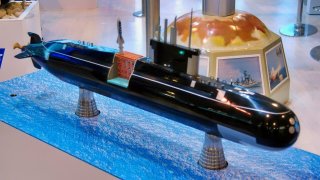Russia's Lada-Class Submarine Packed One Heck of a Military Punch
The Russian Navy, despite recent setbacks in Ukraine, continues to operate one of the world's most formidable submarine fleets, including the advanced Lada-class diesel-electric attack submarines.
Summary: The Russian Navy, despite recent setbacks in Ukraine, continues to operate one of the world's most formidable submarine fleets, including the advanced Lada-class diesel-electric attack submarines. The Lada-class, known for its mono-hull design—a first since World War II—is smaller yet more capable than its predecessor, the Kilo-class. With six 21-inch torpedo tubes and the ability to carry powerful anti-ship cruise missiles, the Lada-class submarines excel in anti-surface and anti-submarine warfare, as well as intelligence gathering. Currently, one active unit, the Kronstadt, is in service, with plans to expand the fleet to up to 12 submarines.
Russia's Lada-Class Submarines: A New Era in Naval Warfare Amidst Conflict
The Russian Navy is taking a serious battering in Ukraine, losing several warships and support vessels to Ukrainian long-range strikes. But Russia still possesses a considerable fleet.
When it comes to submarines, the Russian Navy has one of the largest and most capable fleets in the world, with dozens of vessels of several types.
The newest class of Russian submarines is the Lada class, and it represents the best attack submarines the Russian Navy can field.
The Lada-Class Attack Submarine
The Lada class is a diesel-electric attack submarine specializing in anti-surface warfare, anti-submarine warfare, and intelligence-gathering missions.
Designated as Project 677 Lada by the Russian Navy, the Lada-class attack submarine uses a mono-hull design, a first for Moscow’s attack submarines since World War II. It operates using diesel technology. Designed by the Rubin Design Bureau, Lada-class submarines are smaller than the Kilo class (25% less displacement), but bring improved capabilities to the battlefield.
At approximately 220 feet, the Lada-class submarine packs six 21-inch (533 mm) torpedo tubes and can also lay mines. In addition, it can carry SS-N-27 Sizzler and SS-N-26 Oniks short-range anti-ship cruise missiles. These munitions can reach targets up to 190 miles away and pack high-explosive warheads that can cause substantial damage.
The submarine can reach speeds of 21 knots submerged. It can remain underwater for 45 days with a crew of 34 officers and men.
The Russian Navy has one active Lada-class sub (the Kronstadt) and another (the Velikiye Luki) under construction. The Kronstadt was commissioned in January 2024. The prototype vessel of the class (the Sankt Petersburg) was commissioned in 2010 and used for extensive sea trials.
Overall, the Russian Navy plans to acquire up to 12 Lada-class submarines.
There are three main types of submarines: attack, cruise missile attack, and ballistic missile attack. Attack subs are designed to take out enemy surface combatants and submarines, mainly through torpedoes.
Cruise missile attack submarines can fire cruise missiles against ground and naval targets thousands of miles away, as well as attack surface combatants and submarines with torpedoes.
Finally, ballistic missile submarines are the most powerful of all. They can strike strategic targets at extremely long ranges with ballistic missiles and can carry nuclear warheads.
A Word on Diesel Submarines
Compared to nuclear-powered submarines, diesel submarines aren’t as inferior as one might think. Depending on the specific diesel engine, these subs can be extremely quiet and thus harder to detect with sonar technology.
The Swedish military has particular expertise building extremely stealthy diesel submarines. Its Gotland-class subs are so quiet that during repeated exercises against U.S. Navy warships, they have managed to bypass anti-submarine defensive layers and land training torpedo “hits” against large warships, including nuclear-powered aircraft carriers.
About the Author
Stavros Atlamazoglou is a seasoned defense and national security journalist specializing in special operations. A Hellenic Army veteran (national service with the 575th Marine Battalion and Army HQ), he holds a BA from the Johns Hopkins University, an MA from the Johns Hopkins’ School of Advanced International Studies (SAIS). He is pursuing a J.D. at Boston College Law School. His work has been featured in Business Insider, Sandboxx, and SOFREP.


